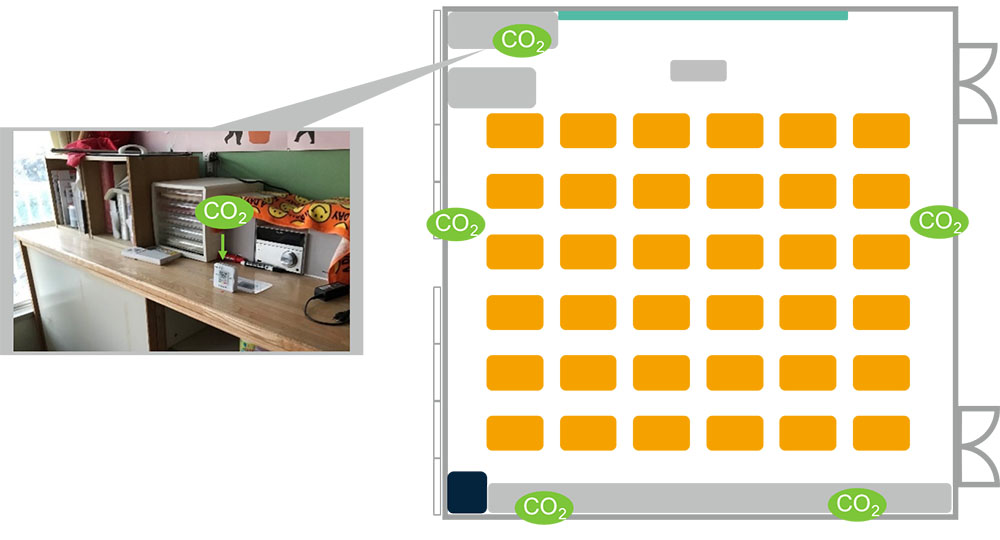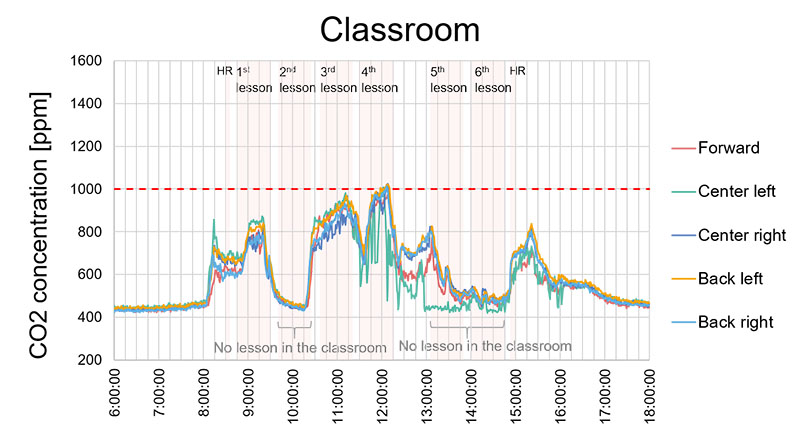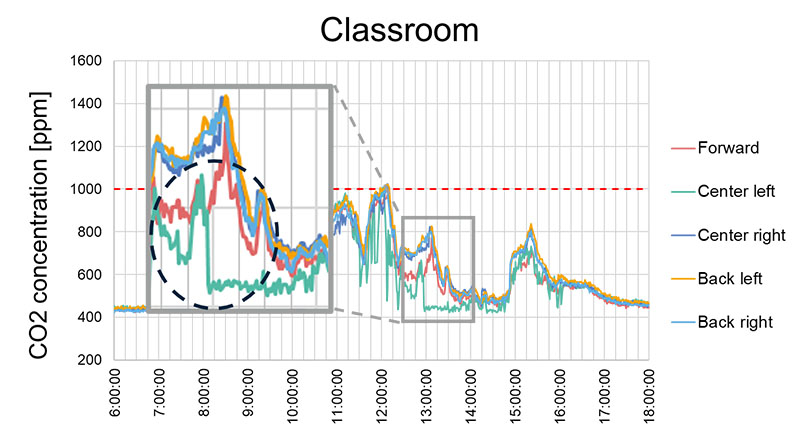Points to Consider When Installing CO2 Sensors
While CO2 sensors have been gaining in popularity, many people do not know how to use them.
In this section, we introduce a number of CO2 sensors and precautions to take when installing them, using the case study on Tagoura Junior High School as reference.
CO2 Sensors
First, blow on the CO2 sensor
When you pick up the CO2 sensor and blow on it, the CO2 concentration rises dramatically.
The concentration of CO2 in air exhaled by a person is approximately 40,000 ppm*, nearly 100 times higher than in the air. Simply blowing directly onto the CO2 sensor will cause the CO2 concentration to rise instantly.
For this reason, it is important that a CO2 sensor be installed in a location where it will not be exposed to a person’s exhalations, so that CO2 concentrations can be measured correctly.
Generally, the concentration of CO2 outside and in the air is about 400 ppm. The measures issued by the Ministry of Health, Labour and Welfare to prevent the spread of the novel coronavirus (COVID-19) *1 recommend that CO2 concentrations indoors be below 1000 ppm, while the environmental health standard for schools is set at 1500 ppm. *2
It is also important to monitor CO2 concentrations from the perspective of improving the learning environment, as reports indicate that the capacity for decision-making drops when CO2 concentration levels are above 2500 ppm.
*Unit indicating parts per million

Next, install a CO2 sensor
To check for differences that may arise due to the location where the CO2 sensors are installed in classrooms, we measured CO2 concentrations at each of the locations shown in Figure 1.
The classrooms were 7.4 m x 8.6 m x 3.0 m in size with approximately 35 students. CO2 concentrations in the classrooms were measured with the windows open.
CO2 sensors were installed as shown in Figure 2: one on the desk in the front of the classroom, one each at the walls on the left and right, and one each on the side along the corridor and windows on the shelf in the rear of the classroom. The CO2 concentration for each sensor is shown in Figure 2.
 Figure 1. Install a CO2 sensor
Figure 1. Install a CO2 sensor
The five CO2 sensors showed roughly the same peak CO2 concentration values and almost the same behavior in terms of changes in concentration. These results confirm that CO2 concentrations for the entire room can be measured correctly if sensors are installed at any of the locations, regardless of position.
If we enlarge the graph, we can see that there is a period of time when CO2 concentrations near the window are relatively low (Figure 3). However, this is due to air from outside blowing into the classroom.
The above results show that there is a relatively high degree of freedom when installing CO2 sensors, and that it is best to avoid locations that are directly exposed to exhaled air or wind from outside to ensure more stable measurements.
 Figure 2
Figure 2
 Figure 3
Figure 3
Start off with an interest in air quality
You may have been able to experience the benefits of visualizing ventilation conditions.
If the CO2 concentration is understood in terms of a numerical value, decisions can be made based on scientific evidence in order to create a safe and secure environment for children.
If results of improvement are also expressed as numerical values, it is not only possible for schools to let parents know that they are opening windows to ventilate classrooms, but can also objectively demonstrate that CO2 concentration levels are below the environmental health standard for schools.
It is still more common to monitor temperature and humidity than CO2 concentrations. First, why not start off by taking an interest in air quality?
In this case, it is important that an NDIR CO2 sensor be used to ensure that no false positives are recorded, and that it is portable with a long battery life so that measurements can be taken easily in various locations.
See below for examples of products using Senseair's ultra-low power Sunrise HVAC sensor.
We hope that this article has inspired you to think more about creating a safe and secure environment.
[Source]
*1: https://www.mhlw.go.jp/content/000695178.pdf
*2: https://www.ncbi.nlm.nih.gov/pmc/articles/PMC3548274/#:~:text=Thus%20CO2%20in%20the,%2C%20health%2C%20or%20work%20performance
About Senseair
Senseair, which became a member of the Asahi Kasei Microdevices (AKM) Group in 2018, is a provider of gas sensors using NDIR: Non-Dispersive InfraRed technology. Our goal is to constantly develop and mass-produce new gas sensor technologies.











